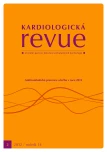Current guidelines for antiplatelet therapy in neurology
Authors:
R. Herzig; M. Král
Authors‘ workplace:
Komplexní cerebrovaskulární centrum, Neurologická klinika LF UP a FN Olomouc
Published in:
Kardiol Rev Int Med 2012, 14(2): 72-77
Overview
Stroke is one of the major causes of mortality and morbidity worldwide. Etiology of ischemic stroke is atherothrombotic in almost 70%, emboligenic in about 30%, other etiologies represent about 1–2%. European Stroke OrganisationGuidelines for the prevention of ischemic stroke and transient ischemic attack from the year 2008 are currently valid. According to these guidelines, antithrombotic therapy, comprising antiplatelet and anticoagulation therapy, is indicated in the primary and secondary prevention of ischemic stroke. Only acetylsalicylic acid (ASA) is being used in antiplatelet therapy in the primary prevention of atherothrombotic stroke. This is being used in the primary prevention of ischemic stroke also in younger patients with non-valvular atrial fibrillation and free of vascular risk factors. Antiplatelet therapy is being used in the secondary prevention of atherothrobotic ischemic stroke with combination of ASA with extended release dipyridamole or clopidogrel alone representing the therapy of choice and, with combination of clopidogrel with ASA being used in exceptional cases.
Keywords:
stroke – brain infarction – transient ischemic attack – prevention – antithrombotic drugs – antiplatelet drugs
Sources
1. Lopez AD, Mathers CD, Ezzati M et al. Global and regional burden of disease and risk factors, 2001: systematic analysis of population health data. Lancet 2006; 367: 1747–1757.
2. Brainin M, Bornstein N, Boysen G et al. V. Acute neurological stroke care in Europe: results of the European Stroke Care Inventory. Eur J Neurol 2000; 7: 5–10.
3. O’Brien JT, Erkinjuntti T, Reisberg B et al. Vascular cognitive impairment. Lancet Neurol 2003; 2: 89–98.
4. Rothwell PM, Coull AJ, Silver LE et al. Oxford Vascular Study. Population-based study of event-rate, incidence, case fatality, and mortality for all acute vascular events in all arterial territories (Oxford Vascular Study). Lancet 2005; 366: 1773–1783.
5. European Stroke Organisation (ESO) Executive Committee, ESO Writing Committee. Guidelines for management of ischaemic stroke and transient ischaemic attack 2008. Cerebrovasc Dis 2008; 25: 457–507.
6. Sacco RL, Ellenberg JH, Mohr JP et al. Infarcts of undetermined cause: the NINCDS Stroke Data Bank. Ann Neurol 1989; 25: 382–390.
7. Kistler JP. Cerebral embolism. Compr Ther 1996; 22: 515–530.
8. Albers GW, Amarenco P, Easton JD et al. Antithrombotic and thrombolytic therapy for ischemic stroke: the Seventh ACCP Conference on Antithrombotic and Thrombolytic Therapy. Chest 2004; 126: 483S–512S.
9. Kral M, Herzig R, Sanak D et al. Oral antiplatelet therapy in stroke prevention. Minireview. Biomed Pap Med Fac Univ Palacky Olomouc Czech Repub 2010; 154: 203–210.
10. Berger JS, Roncaglioni MC, Avanzini F et al. Aspirin for the primary prevention of cardiovascular events in women and men: a sex-specific meta-analysis of randomized controlled trials. JAMA 2006; 295: 306–313.
11. Antithrombotic Trialists’ Collaboration. Collaborative meta-analysis of randomised trials of antiplatelet therapy for prevention of death, myocardial infarction, and stroke in high risk patients. BMJ 2002; 324: 71–86.
12. Adams RJ, Albers G, Alberts MJ et al. American Heart Association. American Stroke Association. Update to the AHA/ASA recommendations for the prevention of stroke in patients with stroke and transient ischemic attack. Stroke 2008; 39: 1647–1652.
13. Lansberg MG, O’Donnell MJ, Khatri P et al. American College of Chest Physicians. Antithrombotic and Thrombolytic Therapy for Ischemic Stroke: Antithrombotic Therapy and Prevention of Thrombosis, 9th ed. American College of Chest Physicians Evidence-Based Clinical Practice Guidelines. Chest 2012; 141 (2 Suppl): e601S–e636S.
14. He J, Whelton PK, Vu B et al. Aspirin and risk of hemorrhagic stroke. A meta-analysis of randomised controlled trials. JAMA 1998; 280: 1930–1935.
15. Kalita Z. Acetylsalicylová kyselina a její význam v léčbě a prevenci ischemické cévní mozkové příhody. Čes a Slov Neurol Neurochir 2004; 67/100: 149–156.
16. Diener HC, Sacco R, Yusuf S. Steering Committee. PRoFESS Study Group. Rationale, design and baseline data in a randomized, double-blind, controlled trial comparing two antithrombotic regimes (a fixed-dose combination of extended-release dipyridamole plus ASA with clopidogrel) and telmisartan versus placebo in patients with strokes: the Prevention Regime for Effectively Avoiding Second Strokes Trial (PRoFESS). Cerebrovasc Dis 2007; 23: 368–380.
17. Diener HC, Cunha L, Forbes C et al. European Stroke Prevention Study 2. Dipyridamole and acetylsalicylic acid in the secondary prevention of stroke. J Neurol Sci 1996; 143: 1–13.
18. De Schryver EL, Algra A, van Gijn J. Dipyridamole for preventing stroke and other vascular events in patients with vascular disease. Review. Cochrane Database Syst Rev 2006; (2): CD001820.
Labels
Paediatric cardiology Internal medicine Cardiac surgery CardiologyArticle was published in
Cardiology Review

2012 Issue 2
Most read in this issue
- Antiaggregating and anticoagulant therapy – basic principles
- Anticoagulant therapy and atrial fibrillation
- Where is a step in the current development of drugs that affect blood clotting?
- Current guidelines for antiplatelet therapy in neurology
